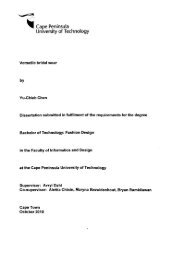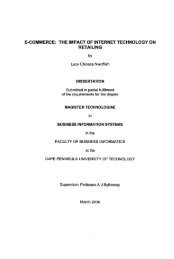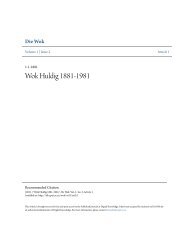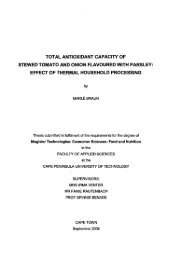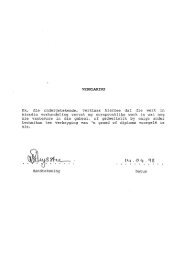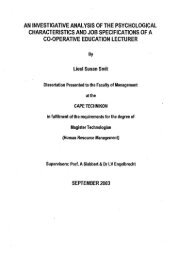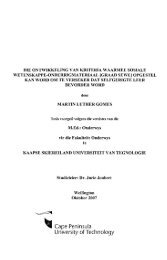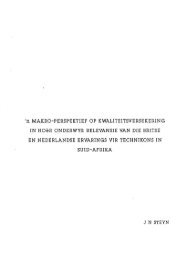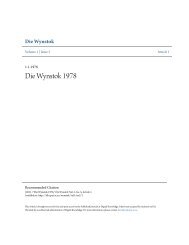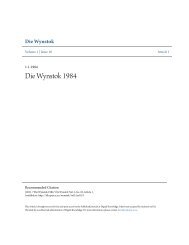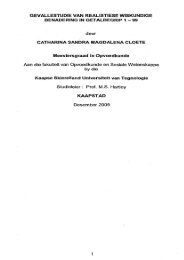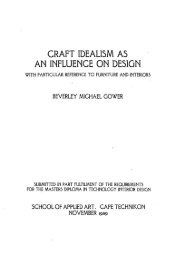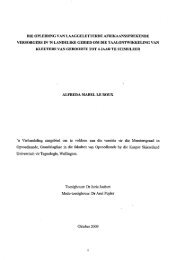the effect of the particle size distribution on non-newtonian turbulent ...
the effect of the particle size distribution on non-newtonian turbulent ...
the effect of the particle size distribution on non-newtonian turbulent ...
You also want an ePaper? Increase the reach of your titles
YUMPU automatically turns print PDFs into web optimized ePapers that Google loves.
Chapter 4 Results and Analysis Page 4.21<br />
Overall <str<strong>on</strong>g>the</str<strong>on</strong>g> Slatter model (APE - 13.9%, LSE - 0.0325) best modelled <str<strong>on</strong>g>the</str<strong>on</strong>g> test data.<br />
Although <str<strong>on</strong>g>the</str<strong>on</strong>g> Torrance model (19.15%) and <str<strong>on</strong>g>the</str<strong>on</strong>g> Wils<strong>on</strong> & Thomas model (19.66%) are both<br />
below an average percentage error <str<strong>on</strong>g>of</str<strong>on</strong>g> 20 %, which is acceptable in engineering practice<br />
(Cheng, 1970), <str<strong>on</strong>g>the</str<strong>on</strong>g> fact still remains that <str<strong>on</strong>g>the</str<strong>on</strong>g>se models diverge from <str<strong>on</strong>g>the</str<strong>on</strong>g> data at higher shear<br />
stresses, indicating that <str<strong>on</strong>g>the</str<strong>on</strong>g>y do not accurately describe <str<strong>on</strong>g>the</str<strong>on</strong>g> <strong>turbulent</strong> flow behaviour <str<strong>on</strong>g>of</str<strong>on</strong>g> <str<strong>on</strong>g>the</str<strong>on</strong>g><br />
solid-liquid suspensi<strong>on</strong>s.<br />
The <strong>turbulent</strong> model performance can also be seen in Figure 4.25 to Figure 4.29 which<br />
shows a log-log plot <str<strong>on</strong>g>of</str<strong>on</strong>g> TO ob' vs To'""" for <str<strong>on</strong>g>the</str<strong>on</strong>g> five <str<strong>on</strong>g>the</str<strong>on</strong>g>oretical models which were c<strong>on</strong>sidered.<br />
A 20 % error line is included in <str<strong>on</strong>g>the</str<strong>on</strong>g> plot. It can be seen from <str<strong>on</strong>g>the</str<strong>on</strong>g> five figures that <str<strong>on</strong>g>the</str<strong>on</strong>g> Slatter<br />
model yields <str<strong>on</strong>g>the</str<strong>on</strong>g> best results with virtually all <str<strong>on</strong>g>the</str<strong>on</strong>g> data points within <str<strong>on</strong>g>the</str<strong>on</strong>g> 20% error lines.<br />
Large discrepancies for mixture 1 for all models can be seen.<br />
From <str<strong>on</strong>g>the</str<strong>on</strong>g> performance <str<strong>on</strong>g>of</str<strong>on</strong>g> <str<strong>on</strong>g>the</str<strong>on</strong>g> various <str<strong>on</strong>g>the</str<strong>on</strong>g>oretical models (visual appraisal <str<strong>on</strong>g>of</str<strong>on</strong>g> <str<strong>on</strong>g>the</str<strong>on</strong>g> model lines,<br />
average percentage error, log standard error and <str<strong>on</strong>g>the</str<strong>on</strong>g> log-log plots) it would appear that <str<strong>on</strong>g>the</str<strong>on</strong>g><br />
Slatter model provides better predicti<strong>on</strong>s than <str<strong>on</strong>g>the</str<strong>on</strong>g> o<str<strong>on</strong>g>the</str<strong>on</strong>g>r models for <str<strong>on</strong>g>the</str<strong>on</strong>g> slurries tested.<br />
1000,.---------------:'71,-----,<br />
o<br />
Kaolin<br />
..<br />
Ntxtu.-. 1<br />
+<br />
Nbcv. 2<br />
Figure 4.25: A log-log plot <str<strong>on</strong>g>of</str<strong>on</strong>g> TO"", vs To""" for <str<strong>on</strong>g>the</str<strong>on</strong>g> Dodge & Metzner<br />
model



